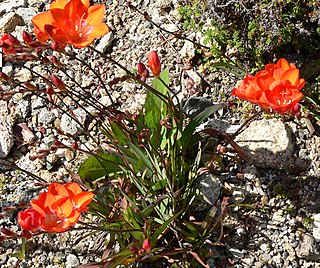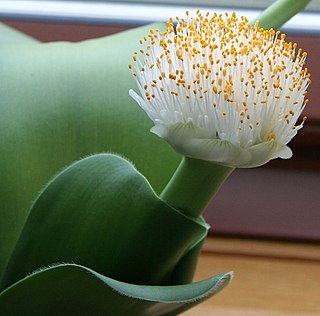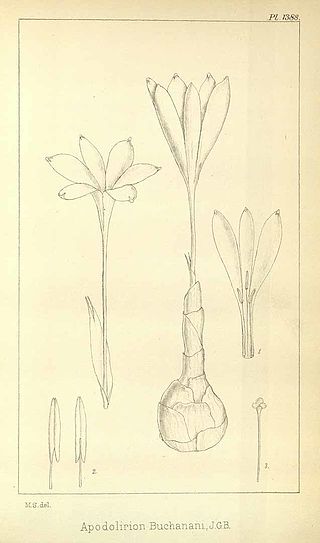
Freesia is a genus of herbaceous perennial flowering plants in the family Iridaceae, first described as a genus in 1866 by Christian Friedrich Ecklon (1886) and named after the German botanist and medical practitioner, Friedrich Freese (1795–1876). It is native to the eastern side of southern Africa, from Kenya south to South Africa, most species being found in Cape Provinces. Species of the former genus Anomatheca are now included in Freesia. The plants commonly known as "freesias", with fragrant funnel-shaped flowers, are cultivated hybrids of a number of Freesia species. Some other species are also grown as ornamental plants.

Euclea, from the Greek eukleia meaning "glory and fame", denotes a group of flowering plants in the Ebenaceae or ebony family. They were described as a genus by Linnaeus in 1774. The genus includes evergreen trees and shrubs, native to Africa, the Comoro Islands and Arabia. Several species are used for timber, producing a hard, dark heartwood timber similar to ebony.

Nerine is a genus of flowering plants belonging to the family Amaryllidaceae, subfamily Amaryllidoideae. They are bulbous perennials, some evergreen, associated with rocky and arid habitats. They bear spherical umbels of lily-like flowers in shades from white through pink to crimson. In the case of deciduous species, the flowers may appear on naked stems before the leaves develop. Native to South Africa, there are about 20–30 species in the genus. Though described as lilies, they are not significantly related to the true lilies (Liliaceae), but more closely resemble their relatives, Amaryllis and Lycoris. The genus was established by the Revd. William Herbert in 1820.

Tritonia is a genus of flowering plants in the iris family first described as a genus in 1802. They are naturally distributed across southern Africa, with a high concentration of species in Cape Province of western South Africa. The genus is closely related to the genus Ixia.

Haemanthus is a Southern African genus of flowering plants in the family Amaryllidaceae, subfamily Amaryllidoideae. Members of the genus are known as blood lily and paintbrush lily. There are some 22 known species, native to South Africa, Botswana, Namibia, Lesotho and Eswatini. About 15 species occur in the winter rainfall region of Namaqualand and the Western Cape, the remainder being found in the summer rainfall region, with one species Haemanthus albiflos occurring in both regions.

Strumaria is a genus of African plants in Amaryllis family, subfamily Amaryllidoideae. The genus is known in nature only from South Africa, Lesotho and Namibia. Almost all species flower in the autumn and are cultivated as ornamental bulbous plants.

Apodolirion is a genus of herbaceous, perennial and bulbous plants in the Amaryllis family. It consists of 6 species distributed in South Africa. The name Apodolirion comes from the Greek and means "stemless flower" and describes the almost sessile flowers of these species.

Ammocharis longifolia is an African species of bulbous flowering plant in the family Amaryllidaceae. It has been placed as the only species, Cybistetes longifolia, in the monotypic genus Cybistetes.
Amellus is a genus of flowering plants in the family Asteraceae described as a genus by Linnaeus in 1759.

Albuca is a genus of flowering plants in the family Asparagaceae, subfamily Scilloideae. The genus is distributed mainly in southern and eastern Africa, with some species occurring in northern Africa and the Arabian Peninsula. Plants of the genus are known commonly as slime lilies.

Boophone disticha is a bulbous tropical and subtropical flowering plant, endemic to Africa. Commonly called the century plant or tumbleweed, Boophone disticha was first collected in 1781 from South Africa by Swedish botanist Carl Peter Thunberg and described by Carl Linnaeus as Amaryllis disticha. Since that time it has been placed in the genera Brunsvigia and Haemanthus, finally coming to rest as Boophone. The genus itself was written in three ways by the author William Herbert, straining the procedures of the rules of nomenclature. The etymology of the genus is from the Greek bous = ox, and phontes= killer of, a clear warning that eating the plant can be fatal to livestock.

Empodium is a genus of flowering plants in the family Hypoxidaceae, first described in 1866. It grows from a small corm which produces lance-shaped or pleated and sometimes hairy, star-shaped flowers and leaves with 10–30 centimetres (4–12 in) long in Autumn season. The genus is native to winter-rainfall areas in South Africa, Eswatini, Lesotho, and Namibia.
- Empodium elongatum(Nel) B.L.Burtt – Lesotho, Eswatini, Lesotho
- Empodium flexile(Nel) M.F.Thomps. ex Snijman – Cape Province
- Empodium gloriosum(Nel) B.L.Burtt – Cape Province
- Empodium monophyllum(Nel) B.L.Burtt – KwaZulu-Natal, Eswatini
- Empodium namaquensis(Baker) M.F.Thomps. – Cape Province
- Empodium plicatum(Thunb.) Garside – Cape Province
- Empodium veratrifolium(Willd.) M.F.Thomps. – Cape Province

Crossyne is a genus of South African flowering plants in the Amaryllis family.

Pauridia is a flowering plant genus in the family Hypoxidaceae. It is native to southern Africa, and southern Australia. It has been introduced into New Zealand. The southern African species have been transferred from the genus Spiloxene.

Gethyllidinae is a small subtribe within the amaryllis family. It is within tribe Haemantheae, and therefore within the African clades of Amaryllidoideae. It contains two genera, Gethyllis and Apodolirion, both are endemic to southern Africa.

Lobostemon is a genus of flowering plants belonging to the family Boraginaceae. It is endemic to the Cape Provinces of South Africa. The majority of species are limited to the winter rainfall area of the country, from Springbok to Mossel Bay. In Afrikaans these species are known as agtdaegeneesbos, or loosely translated, bush that will heal in eight days. As this name suggests, many species have medicinal properties. This is best known from Lobostemon fruticosus, which is used for treating wounds, blood poisoning, ringworm, skin diseases and syphilis.
Strumaria massoniella is a species of flowering plant in the family Amaryllidaceae, native to the Cape Provinces of South Africa. It was first described in 1985 as Gemmaria massoniella. Its bulb is solitary. Like other members of the genus Strumaria it has star-shaped flowers. In the Northern Cape Province, it is found in sandy plains at an elevation of about 1,000 m (3,300 ft).

Strumaria watermeyeri is a species of flowering plant in the family Amaryllidaceae, native to the Cape Provinces of South Africa, where it is found in dry areas in the northwest. It is usually solitary, and has pink or white flowers. It was first described by Louisa Bolus in 1921.















